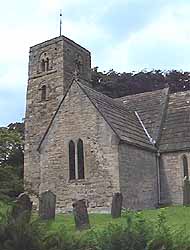
EBK Home
Kingdoms
Royalty
Saints
Pedigrees
Archaeology
King Arthur
Adversaries
For Kids
Mail David
 St.
Andrew's Church, Bywell
St.
Andrew's Church, BywellFounded in the 7th Century
Bywell is a strange place. There is no village, yet two churches right next to each other! It sits at the boundary of two Norman baronies in Northumberland. St. Peter's was actually the church of Bywell where the castle and Bywell Hall remain. St. Andrew's served the now non-existent community of Styford.
Both churches pre-date the Conquest, but only St. Andrew's is substantially Saxon in date. The first church - from which only one carved stone remains - may have been founded by St. Wilfred in the 7th century, but its circular churchyard shows even more ancient origins. The base of the present tower, however, dates from shortly before AD 850; possibly from around the turn of the century when Danish raids forced members of the diocenal community on Lindisfarne to seek refuge here. Egbert was consecrated bishop in St. Andrew's in AD 803. The upper stages of the tower are 10th and 11th century, making it one of the finest Anglian structures in Northumbria.
The body of the church is mostly 13th century. It houses some fine Victorian glass by William Wailes, who is buried in St. Peter's; a number of hatchments and a fascinating collection of medieval grave-slabs. These date from the mid-12th to 14th century. The Victorians placed them in the outside wall, but several have now been moved inside for better preservation. They feature elaborate crosses and emblems denoting the occupant's status: a sword for the right to bear arms, shears for a housewife, hunting-horns, tongs and a rectangular object: possibly a book or lady's work-box.
The Church is owned and opened to the public by the Churches Conservation Trust. Admission free, but donations welcome.
